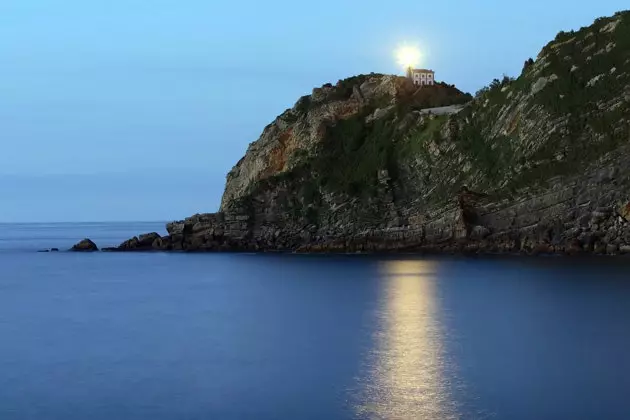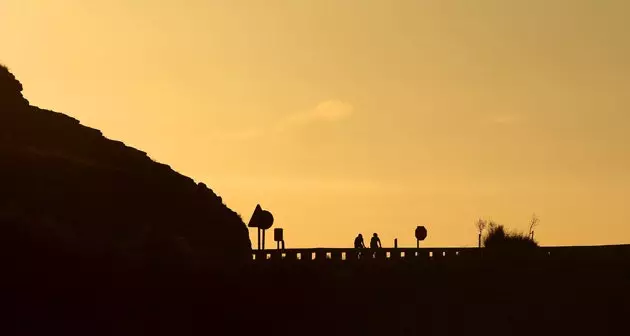
Mount of San Anton
Autobiography. Stop. I am the N-634, a humble road and the heap that born in the outskirts of San Sebastián and died in Santiago de Compostela . I don't know very well when I was born, nor when I will die. I only know that I have one of the sections of Spain closest to the sea, between Zarautz and Getaria, in Guipúzcoa. It's so close that when the Cantabrian gets drunk, it splashes me. Plus I'm free . If you start driving through my zero kilometer, next to the N-I, in San Sebastián, maybe you can enjoy these alternative tips.
Unauthorized biography. Stop. Only a madman or a fool would cross the Cantabrian coast on the N-634 , a desperate road for those poor unwary who go through life in a hurry. That is why it is wonderful, because there was a time –before the current one of the ring roads- in which to travel 100 kilometers it took more than three hours. The Gipuzkoan section is not particularly beautiful but it is genuine, alternating industrial estates with fertile riverbanks, lots of pine and, most importantly, a couple of harrowing stretches along the coast.
Go to a town and not visit it. Stop. Usurbil It appears on maps (of course), but not in tourist brochures. Okay. The town does not have much to see but its surroundings and, above all, a neighborhood close to it, that of San Esteban. An amazing pagan invention is kept inside its church: a stone with a hole in which you can put your head to cure all kinds of ills related to bolus. It is difficult to catch it open, unless there is a wedding party or a festive mass, but even so it is worth going up (by car) for the views over the Oria valley.
Mandatory menu. Stop. With the txangurros (brown crab) that are cooked daily in the Saltxipi the Earth could be repopulated after a nuclear catastrophe. The Saltxipi is also in the neighborhood of San Esteban. The other obligatory dishes of this family restaurant are the baked monkfish, ribeye and a cheesecake so perfect that it borders on the sexual. Do not overdo the spider crab croquettes that serve as an appetizer. Moderation.
Orio, the forgotten beach. Stop. It is hard to believe that, until a few years ago, Orio beach had not been urbanized. There was hardly a beach bar, and a parking lot full of mud and potholes. Then came the houses and the place lost its innocence, but its beach is still a wild and dangerous place by strong currents. A very good panoramic view of this is obtained from the hermitage of San Martín, in the highest part of its old quarter. The cemetery that is located nearby also has cloth: you want to die to rest there.
Zarautz. Lying Nazis. Real campsites. Stop. Although some are no longer old enough to air sleeping bags or shower with flip-flops, it should be announced that there is no accommodation in Zarautz with better views than the village campsite, on top of Mount Talai, perfectly lined up with the longest beach in Guipúzcoa, and one in which the surf culture is most breathed. In 2011 there was some confusion (to call it something) when Mariano Rajoy -or his editor- chose a photograph taken in that same place, with the Mouse of Getaria in the background, to illustrate the cover of his biography, ' In confidence'. In the town, of course, they freaked out.
The N-634 runs through Zarautz as if it were its backbone and several vehicles with swastikas paraded along it in 1967, during the filming of the movie 'The Battle of Britain'. Several sequences were recorded here in which Zarautz was not Zarautz, but a French town located in the Pas de Calais during the German occupation . It's funny to see the fake Nazis scan the horizon of Gipuzkoa and imagine that, in the distance, is England, the enemy.

The highway at the height of Getaria
Getaria. Now yes. Now comes the good stuff. Stop. Zarautz is left behind, its port on our right (look at this video recorded a couple of years ago) and the best section of the entire N-634 begins, right next to the Cantabrian, just three meters above it and boxed in by a stone wall. rocks that, when the rain falls badly 'esne' ('milk', in Basque) collapses and forces the residents of Zarautz or Getaria to take a deadly detour to reach one town or another. By the way, there is a sailor bust on the promenade that, seen from behind, looks like a tribute to Darth Vader. If a ranking of Spanish roads were made, this would be at the top.
Elcano and manure. Stop. In Getaria you eat very well but almost everything you need to know has already been written by a certain Jesús Terres here. The illustrious sons of the town are two: Balenciaga, which has a museum; and Elcano, which does not have a museum but does have three monuments , one of them so outrageous that it could house an interpretation center. Beyond the obvious (the mouse-mountain of San Antón, its leaning church crossed by a tunnel, the fish grills in the port); Laurence Bergreen's (sensationalist and highly entertaining) book on Magellan is worth taking a look at because the writer throws a bit of manure on the immaculate figure of the sailor from Getaria.
He plays and fugues. Stop. The section of the N-634 that remains until Zumaia also has its point, but it is not as daring as the previous one. For not having, here there are hardly any landslides. It may be that some unscrupulous person is unfaithful to the National to go up to the Askizu neighborhood -the road begins on the left, shortly after leaving Getaria- and so on. take a look at the txakoli vineyards, spectacular now that they are about to strip for winter. It will do well.
